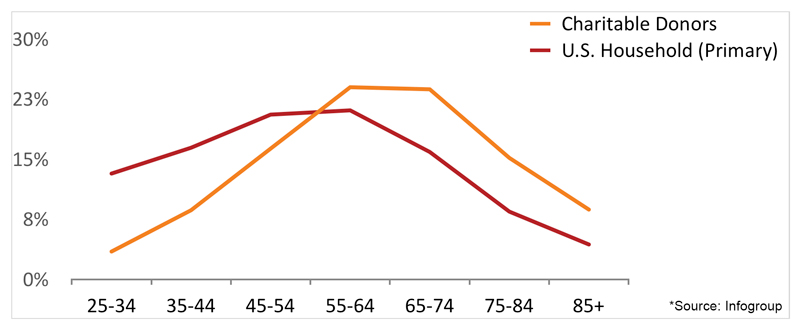August 31st, 2020
Successful donor-centric fundraising programs require a deep understanding of your audience. The demographics and lifestyle psychographics of your donors can be attained through a profile and benchmarking against the general population, or various comparisons among different audiences on your file or in the nonprofit sector.
Generally, charitable donors are older as compared to the general U.S. household population, with an average age for charitable donors at 60-65 years with more than 70% of donors older than 55.

Although it can fluctuate depending on the cause or sector, we more commonly find that supporters skew female, regardless of age. The two data points of age and gender beg the question, “Are your donors your Mother?” Statistically speaking, your mother is indeed more likely to be a charitable donor than a random individual because she is older than you and female, but obviously not all donors are similar to your mother.
Taking a closer look at your supporters can yield significant differences simply based on their activity and interactions. We have observed several trends for a variety of nonprofits based on modeling, analysis and profiling conducted by MarkeTeam over the years. Here are just a few of the common themes we have uncovered:
Online Donors
Online donors are typically younger when compared to offline donors, but their average age is still around 50-60 years old. Online donors tend to have higher income and wealth than offline donors and typically make larger donations—somewhat due to the fact that most are still employed. Unsurprisingly, they exhibit many other online behaviors such as online investing, paying bills online, using Wi-Fi at home and making purchases online.

Monthly Pledge/Sustaining Donors
Monthly sustaining donors tend to profile similarly to online donors with a slightly older average age and a few other subtle differences. Although they support other charities similar to other donors their age, they typically support fewer organizations and concentrate their giving to a smaller number.
Offline-Only Donors
Offline donors tend to be older when compared to online donors, with an average age of 60-75 years old. Most are empty nesters with <20% having children in the household. Offline donors tend to spread their donations across more organizations. Compared to the general population, offline donors have lifestyle behaviors that involve investing in low risk investments and annuities, using professional tax services, joining golf clubs and taking vitamins regularly.
Mid-Level & Major Donors
Mid-Level and major donors profile similarly to offline donors, but as you would expect they are wealthier and have higher incomes. Major donors have the highest net wealth, but do not necessarily have a higher income than Mid-Level donors since they are more likely to be retired. Mid-Level donors are generally about the same age as offline donors with major donors being slightly older. Major donors tend to focus their giving to fewer charities compared to Mid-Level donors.
Planned Giving Prospects
As you would assume, planned giving prospects are typically older supporters but there are also subtle differences among the cohorts. Prospects for appeals with information on initial estate planning tend to be younger (55-64), while identified planned giving donors falling into the 75+ age range. Planned giving prospects with a long history of giving often decrease their annual giving as they age or after they have included charities in their wills.
The differences among your charity’s supporters demonstrate the need to better understand the audiences for communications. With demographics forming the foundation of your knowledge, layering in behavioral data provides an opportunity to further enhance targeting and messaging. With the right tools and data available, personalizing communications based on these observations, or observations about your supporters in particular, can have a significant impact on how to appeal to your base of supporters.

Blog written by
Andy Johnson | Vice President of Analytics
Share This Post
